5 Comics To Read Before Watching The Batman
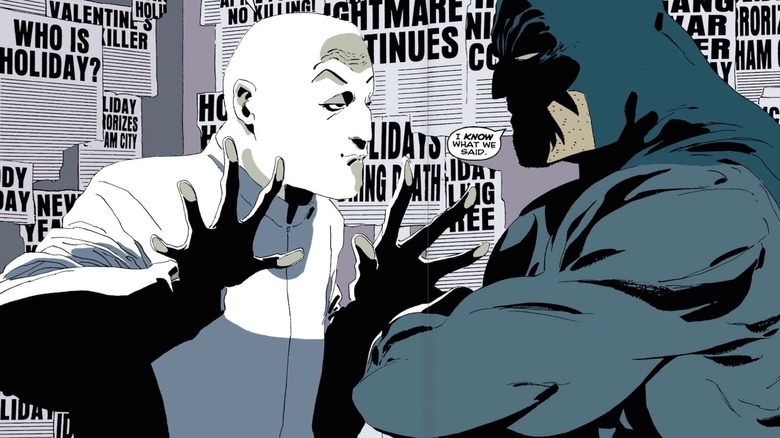
The influences behind "The Batman" run the gamut from movies to art to books, with David Fincher's "Zodiac," Edward Hopper's "Nighthawks," and even Stephen King's "Christine" being sources of inspiration. Above all, there is the film's comic book source material, which director Matt Reeves has been citing since the days back when Ben Affleck was still attached to the project, before Robert Pattinson was even cast as Batman.
According to Reeves, "The Batman" is not an adaptation of any particular comic, but it does draw loose inspiration from several tales published by DC. As he was headed into the Batcave to co-write the script with Peter Craig, Reeves said, "I went on a deep dive again revisiting all my favorite comics."
Fans may be looking to do the same thing. Batman has a long and winding history, however. His first appearance in "Detective Comics" — DC's namesake — was in 1939, just months before World War II broke out. With so many decades of stories under his utility belt, it can be hard to know where to start. This is further complicated by the movie featuring three of Batman's greatest villains: Catwoman (Zoë Kravitz), the Riddler (Paul Dano), and the Penguin (Colin Farrell), all of whom might merit their own separate reading lists.
Fortunately, DC has its own official starter pack, "The Batman Box Set," coming the week "The Batman" hits theaters. It's a slipcase with softcover editions of three pivotal graphic novels that inspired the feature film: "Batman: Year One," "Batman: The Long Halloween," and "Batman: Ego and Other Tails." All three are available individually, so you don't have to wait for the box set to read them. Here, we'll take a look at them and two other comics worth checking out before watching "The Batman."
Batman: Year One
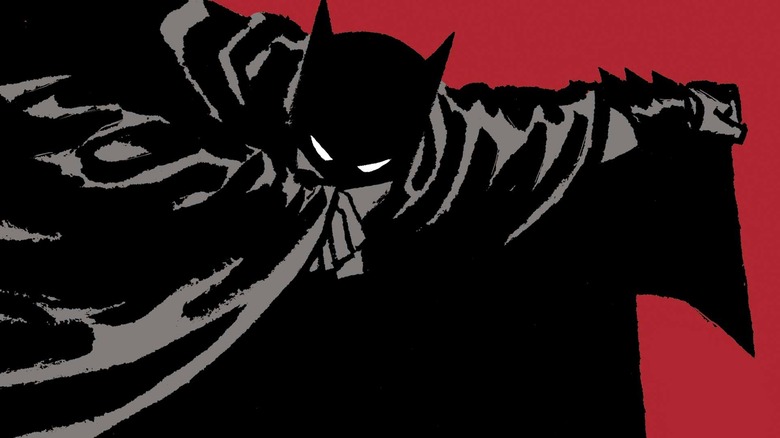
"Batman: Year One" is weighted equally to Jim Gordon and Bruce Wayne, who arrive in Gotham City at the same time, one by train, the other by plane. Gordon memorizes his new, corrupt cop partner's Green Beret moves "for future reference" and hopes that his wife isn't pregnant because Gotham is no place to raise a family. Batman kicks down trees and punches guys through brick walls, but he's still a "lucky amateur" who is learning the vigilante ropes.
Even if you've never read "Year One," you may already be familiar with certain moments through "Batman Begins," such as the scene where a SWAT team corners Batman in a building and he summons a flock of bats to escape. There's also the scene where the crooked cop Flass witnesses Batman bust up a drug shipment, and the scene at the end with Gordon on the rooftop teasing the Joker's emergence.
The core ethos in "Year One" of "a credible Batman, grounded in a world we recognize," as artist David Mazzuchelli put it, contains the pseudo-realistic seeds of Christopher Nolan's "Dark Knight" trilogy. For "The Batman," Reeves has Jeffrey Wright playing Gordon, and he's adopted the short-haired Selina Kyle of "Year One." Dano's Riddler shows up in the "Nighthawks"-esque diner where Gordon and his mistress, Sarah Essen, regularly meet for coffee in the comic (which names the diner "Hopper" in a nod to the painter).
As much as "Year One," first published as "Batman" #404—407 in 1987, may have influenced Nolan and Reeves, it also drew influence from earlier movies. Mazzuchelli's version of Wayne is modeled on photos of Gregory Peck, the same actor who would inspire the look of the older Wayne in the Elseworlds tale, "Kingdom Come." When Wayne dons an army jacket for a reconnaissance mission in Gotham's red-light district, Frank Miller's script notes, "The clothes should make him look like he's trying out for the Travis Bickle lookalike contest."
Batman: The Long Halloween
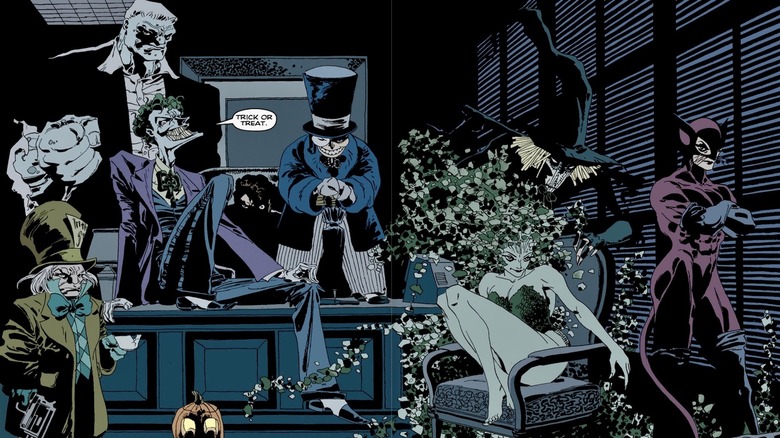
"Batman: The Long Halloween" is also indebted to film history and it reads like a sequel to "Year One." Editor Archie Goodwin approached writer Jeph Loeb and artist Tim Sale about playing in the sandbox of discarded gangsters from Miller's origin tale. He envisioned it as a film noir evocation, and there are certainly enough shadows and Venetian blinds in it to justify that comparison.
The story opens with an homage to "The Godfather," with Bruce Wayne looking at the reader, saying, "I believe in Gotham City." He's in Carmine "The Roman" Falcone's office and there's a wedding reception happening outside. Throughout the story, there will be other allusions to and outright paraphrasing of "The Godfather" movies.
If "Year One" was as much Gordon's story as it was Batman's, then "The Long Halloween" makes a case for itself — right alongside the two-part episode of "Batman: The Animated Series — as the definitive telling of Harvey Dent's transformation from golden-boy D.A. into the tragic villain, Two-Face. Published as a 13-issue limited series from 1996 to 1997, the title refers to the ongoing mystery of who the Holiday killer is. Someone is bumping off figures in the world of organized crime on holidays, starting with Halloween, and Batman will have to use his detective skills to solve the case.
Loeb and Sale bring to bear the full force of Batman's peerless rogues gallery. The Riddler, for one, comes in at the halfway point on April Fools' Day to guess suspects. Here, too, are images that made their way into Nolan's films, such as the three-way alliance of Dent, Gordon, and Batman on the roof, or the burning of a mob boss's stockpile of cash in a dockside warehouse.
"The Batman" will tap into the "world's greatest detective" spirit of "The Long Halloween" and other classic Batman stories. On Twitter, Reeves also mentioned the sequel, "Dark Victory," as one of his favorite Batman comics, along with the pioneering work of Neal Adams and Batman creators, Bob Kane and Bill Finger.
Batman: Ego And Other Tails
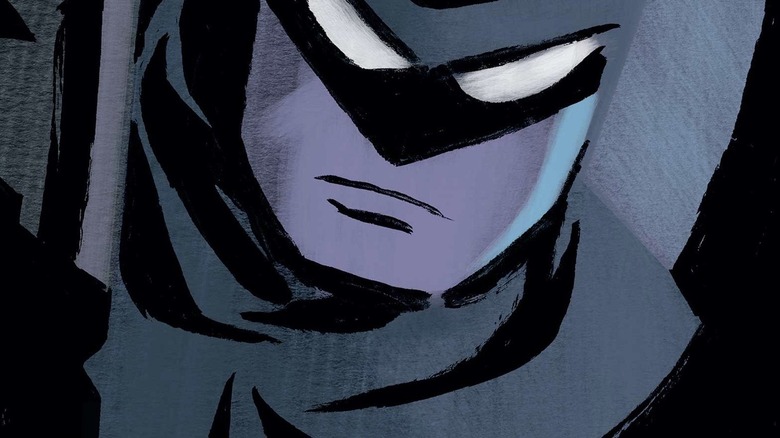
The one-shot "Batman: Ego" was the first project that the late artist and writer Darwyn Cooke did for DC Comics in 2000. This collection includes that comic and most of Cooke's other Batman-related work. "Batman: Ego" is subtitled "A Psychotic Slide Into the Heart of Darkness," and it does see Bruce Wayne indulging in some self-described "morbid introspection." Here, the Batman side of him acts as the Ghost of Christmas Past, walking him back through his childhood memories and trying to talk him into a "self-induced psychosis," or "voluntary splitting" of personalities.
We see how, at an early age, it became a primordial symbol of death and the fear that lives within him, a fear he would later turn against criminals. Cooke likens it to the spirit of a great warrior inhabiting a simple tribesman in some ancient culture. Now, that spirit wants to be let off the leash so it can kill the Joker and thereby put an end to his homicidal sprees once and for all.
Pattinson's Batman, likewise, struggles to control his rage, and he's bound by the same rules of engagement as his comic book counterpart. "Ego" shows the precedent that some superhero films have ignored when it has Wayne tell his Batman persona, "There is a line we may never cross. No killing. It is the only difference between us and them."
The version of "Batman: Ego" that's out there now is a collected edition that includes the 2002 graphic novel, "Catwoman: Selina's Big Score," which sees Selina embarking on a train heist. That, and the 11-page Batman and Catwoman story, "Date Knight," with Cooke's words and Sale's art, should help get you primed for the interactions between the Bat and the Cat in "The Batman."
Batman: Hush
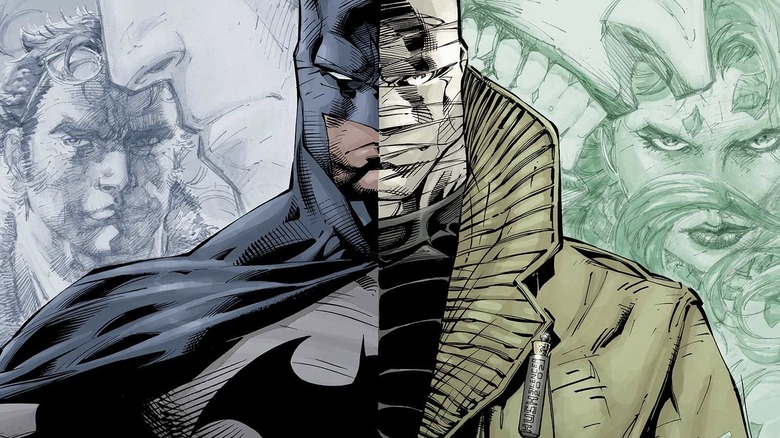
"Hush" was originally a 12-issue story arc that played out from 2002 to 2003 in the pages of "Batman" #608—619. It brought Jim Lee, artist of the bestselling comic of all time, "X-Men" #1, to the monthly "Batman" title and marked his first substantial work for DC beyond one previous back-up story. Two decades later, he's now the company's publisher and chief creative officer.
"Hush" teamed Lee with Loeb, who again put Batman through the paces of a year-long mystery with guest stars galore. Both heroes and villains would show up in the panels of this story: Killer Croc, Catwoman, Poison Ivy, Huntress, Superman, Harley Quinn, Joker, Nightwing, Talia and Ra's al Ghul, Robin, Scarecrow, and more. The Penguin comes up short here (and pretty much everywhere on this list), but we do get the kiss heard 'round the world between Batman and Catwoman.
Though "Hush" takes its name from a new bandaged baddie in a trench coat, its brief but effective treatment of the Riddler, aka Edward Nygma, is what really warrants its inclusion on this list. When the Riddler first appears, he's hijacked an armored truck, and as Batman observes, "Everything about him has become routine." He leaves lame clues and runs through the sewers with a bag of money and doesn't come off as anything more than a petty crook who should have retired by now.
"I used to be somebody in this town," Nygma opines. "Now, everybody has a gimmick." By the end, however, "Hush" restores some legitimacy to the Riddler as a criminal mastermind capable of deducing Batman's secret identity and pulling even the Joker's strings. The only thing keeping him from exposing Bruce Wayne to the world is that "a riddle that everyone knows the answer to is worthless." Trailers for "The Batman" have suggested that Dano's Riddler might also know Wayne's secret and be targeting him for his family history.
Batman: Zero Year
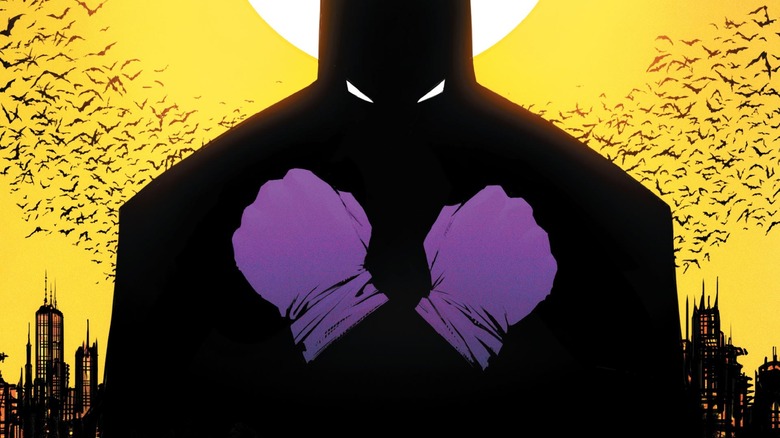
Though "The Batman" is set during the second year of the Caped Crusader's crimefighting career, it doesn't appear to be pulling much from the actual "Year Two" comics storyline. However, there are a few indications that it is utilizing elements of "Zero Year," Scott Snyder and Greg Capullo's arc from "Batman" (vol. 2) #21–27 and #29–33.
This story was published from 2013 to 2014, then reprinted in two volumes before being collected in a new single volume in 2021. Taking place after one of the many relaunches that has reset DC's continuity over the years, the story follows Bruce Wayne's early days in Gotham. He's 25 again, ready to declare, "I shall become a bat," as he did in "Year One," only this time, he's got a more aerodynamic haircut. At various points, we see him as Batman on a motorcycle without his cape, similar to what we've glimpsed in set photos from "The Batman" (via The Hollywood Reporter).
Trailers and TV spots for "The Batman" have shown the streets of Gotham flooding and Batman leading people through the dark with a red flare. In "Zero Year," after Batman blacks out a few city blocks (in the shape of a bat, naturally), the Riddler does him one better and takes control of the power grid, plunging the whole city into darkness. Gotham's citizens, including Jim Gordon, draw bats on flashlights and searchlights and use them as makeshift Bat-Signals. There's also a super-storm bearing down on the city and Riddler blows the retaining walls and floods the streets.
Don't expect to see Paul Dano playing destructive dominoes with buildings, or Batman hanging upside-down from a blimp or flying his own dirigible, or the hot mess that is Dr. Death, a revamped eyesore villain whose body is a beanstalk of bones. ("Put your claws in the air," Gordon tells him.) Not everything in comics translates well to movies ... but if you've recently read or reread these five comics, you might be able to spot some cool Easter eggs in "The Batman."
Read this next: Superman Movies Ranked From Worst To Best
The post 5 Comics to Read Before Watching The Batman appeared first on /Film.
from /Film https://ift.tt/kiYHhjI
No comments: